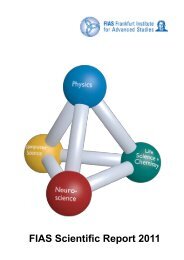FIAS Scientific Report 2010 - Frankfurt Institute for Advanced Studies ...
FIAS Scientific Report 2010 - Frankfurt Institute for Advanced Studies ...
FIAS Scientific Report 2010 - Frankfurt Institute for Advanced Studies ...
Create successful ePaper yourself
Turn your PDF publications into a flip-book with our unique Google optimized e-Paper software.
Production of multi-hyper-nuclei in peripheral heavy-ion collisions<br />
Collaborators: I.N. Mishustin 1 , J. Steinheimer 1 , M. Bleicher 1 , A. Botvina 1,2 , K. Gudima 3<br />
1 <strong>Frankfurt</strong> <strong>Institute</strong> <strong>for</strong> <strong>Advanced</strong> <strong>Studies</strong>, 2 <strong>Institute</strong> <strong>for</strong> Nuclear Research, RAS, Moscow, 3 <strong>Institute</strong> of Applied Physics,<br />
Moldavian Academy of Sciences<br />
We study a new mechanism of hyper-nuclei production in peripheral collisions of relativistic nuclei when hyperons<br />
are produced in secondary reactions and can be captured by spectators. In this way, a piece of relatively<br />
cold (multi-)strange nuclear matter can be <strong>for</strong>med in the laboratory under conditions similar to the interiors<br />
of neutron stars. In the following this excited strange matter will disintegrate into several ordinary and<br />
hyper-fragments. Experiments on production of hyper-nuclei in relativistic nucleus-nucleus collisions are now<br />
under-way at GSI (HypHI collaboration) and are also planed <strong>for</strong> FAIR. Within this project we have developed<br />
a hybrid approach <strong>for</strong> description of hyper-fragment production in such reactions. The first dynamical stage of<br />
the reaction is described by the Quark Gluon String Model (QGSM) or by Ultra-relativistic Quantum Molecular<br />
Dynamics (UrQMD), which have demonstrated previously a very good description of strange hadron production.<br />
We have applied a new criterion <strong>for</strong> the absorption of produced hyperons, e.g. Λ is captured when its<br />
kinetic energy is less than the hyperon potential generated by surrounding nucleons. The characteristics of<br />
the hyperonic spectator matter and probability of producing multi-strange systems were also investigated. For<br />
reliable predictions we need to generate about 10 6 events. The calculations are per<strong>for</strong>med at the CSC using<br />
a vectorization algorithm. Our calculations show that double- and even triple-Λ-hypernuclei can be produced<br />
by the proposed mechanism. This project is a very good example of the close cooperation of different <strong>FIAS</strong><br />
groups.<br />
X 20<br />
15<br />
10<br />
5<br />
0<br />
-5<br />
-10<br />
Au(20 GeV/A)+Au → Λ abs + x<br />
P<br />
T<br />
Y+N=Λ+N<br />
AK+N=Λ+π<br />
N+N=Λ+K+N<br />
π+N=Λ+K<br />
-10 -7.5 -5 -2.5 0 2.5 5 7.5 10<br />
Y<br />
Projections of the Λ-hyperon absorption points on the X-Y plane perpendicular to the beam axis. The counters of the<br />
projectile (P) and target (T) nuclei are shown by the circles. The various processes leading to the hyperon production<br />
are shown by different symbols. One can clearly see the accumulation of the absorbed Λ’s in the spectator parts of the<br />
colliding nuclei. Presented results correspond to 10000 events.<br />
Related publications and talks in <strong>2010</strong>:<br />
1. A.S. Botvina, K.K. Gudima, J. Steinheimer, M. Bleicher and I.N. Mishustin, Production of spectator<br />
hypermatter in relativistic heavy-ion collisions, paper in preparation;<br />
2. Igor Mishustin, Production of hypernuclei in relativistic heavy-ion collisions, invited talk at the International<br />
Workshop “Strangeness in Nuclei” (ECT*, Trento, November 3-7, <strong>2010</strong>).<br />
34

















